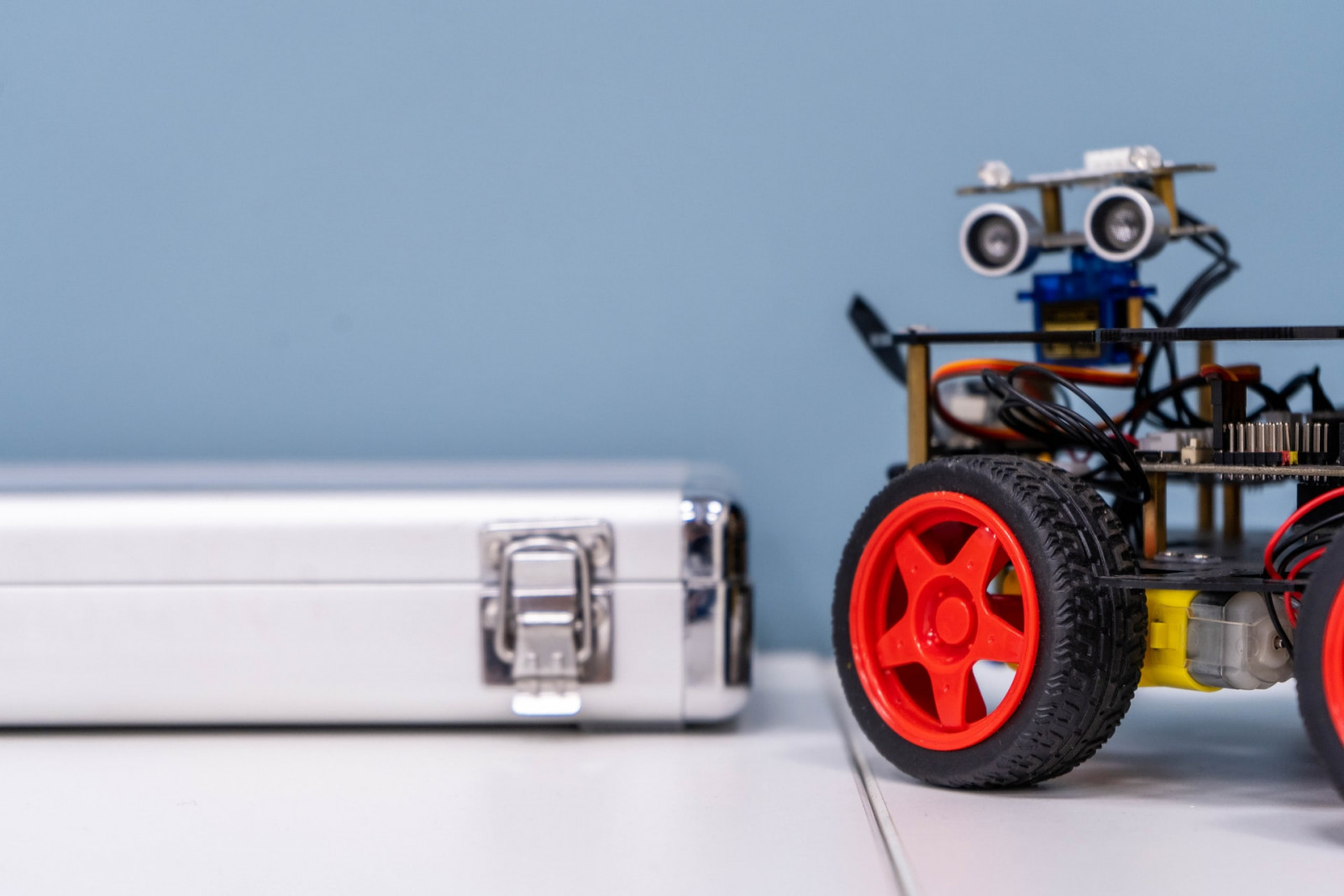Here's How to Build a Robot at Home

Anyone can build a robot at home with the right steps. This guide will cover the basics of building homemade bots, from design to construction to programming. Most beginner robots will be fairly simple, but creating one is half the fun. It’s a great way for everyone, new and experienced alike, to learn more about engineering and electronics.
Deciding What Kind of Robot to Build
Most makers plan to complete a robotics project sooner or later. However, before buying parts, they need to decide their robot’s purpose. There are different things a homemade bot can do, but people need to have a clear goal to aim for.
For example, someone could build a robot that follows lines on the floor using a camera or sensor. Similarly, they could create a remote-control robotic arm that can pick things up or a rover. Designers can start by thinking of things they might like to use a robot for. Once they have a handful of ideas, they should carefully consider which ideas might be feasible.
It certainly sounds exciting to make a full-scale replica of a Star Wars robot that can rove around autonomously and talk. However, that will probably be much more complicated than most makers and hobbyists can handle. In fact, a robot like that would be quite a feat for a professional engineer. It’s best to stick to smaller-scale bots with a simple, specific function. Makers can easily try some common beginner robotics projects at home, such as a line follower or soccer robot.

Creating the Robot Design
The design is one of the most important parts of the robot building process. It will act as a guide and set the stage for the programming phase. It doesn’t need to be a fancy 3D CAD model — it can be as simple as a paper sketch. The important part is that it shows, in detail, what the robot will look like, how it will function and all the parts that will go into it. Makers only need CAD designs for robots they plan to build out of 3D printed parts, which might be better for more advanced at-home robotics projects.
For example, if a maker decided to build a line follower robot, they could start by drawing it from a few different angles, such as top, side and bottom. The drawing would show where the robot’s microcontroller board would go, how its wheels and motors would be attached, where its power source would be, and where the infrared sensor would be mounted. Graph paper can be helpful, as well as different-colored pens or pencils.
At this stage, makers should begin considering the parts the robot will be made out of. Whether these are 3D-printed components, pieces from a robotics kit, or even cardboard and duct tape, try to reflect the building materials in the design.
Choosing Robotics Supplies
Most homemade robots include a similar collection of core parts: wires, motors, a power supply, electronic components like a power switch and LEDs, and a microcontroller board. The microcontroller will be the “brain” of the robot that gets programmed and connected to all the different parts. Depending on the type of bot a maker decides to build, things like wheels, rubber bands, gears and sensors might also be needed.
There are generally two ways to get the supplies for a homemade robot: a robotics kit or 100% DIY. Many robotics kits available today come with loads of different parts for creating custom machines. These can be a convenient way for beginners to get started. People who are more experienced can try building with hand-picked components. A complete DIY robot is a great project for anyone hoping to be a robotics technician or engineer.
Robotics Kits
Robotics has become a popular hobby today, so there are many different kits out there that anyone can use to build a robot at home. Some of these kits only include parts to construct a specific bot or two, while others have hundreds of components to use for any kind of DIY robotics project. One of these kits can simplify the robotics building process for beginners since an expert will have already selected high-quality parts.
Before buying a DIY robotics kit, check the robot’s design. Makers must carefully compare the machines they want to build with the parts included in the box. It can be helpful to find reviews and see what robots others have created with different kits.
Complete DIY
It’s a good idea to research the basics of electronics and understand the different parts and how they work. It’s important for makers to know the different purposes for each type of wire prior to assembly so they purchase the right ones. They will need a clear understanding of electronics, including how resistors work, how motors work, and how electronic components connect to breadboards and microcontrollers.
Most homemade robots are controlled by a battery-powered microcontroller, which is a small circuit board like the popular Arduino Uno. These boards are easy to work with, even for beginners. Makers can find them for a fairly low price on Amazon or in most electronics stores. The Raspberry Pi is also popular for some applications.

Constructing the Robot
Every maker needs some tools to build a robot. A good starter set will include Philips head screwdrivers in a few different sizes, hex keys, small wrenches, duct tape, electrical tape, a flashlight, wire trimmers, a digital multimeter, and a soldering iron and a glue gun.
Some makers may not need all these parts, depending on the type of robot they create and what it is made of. For example, someone may only need a soldering iron for more advanced projects that require attaching parts to a custom circuit board.
The construction process will obviously be different for every unique robot. However, certain steps can be a good starting point for just about any homemade bot.
Building Area
People should start by setting up the building space. They need a table that is cleared off and wiped down. An anti-static work mat is also helpful for building on and protecting electronic parts. All the pieces should be organized on the table, separated into structural elements, each electronic component, the microcontroller and breadboard, tools, and the computer that will be used to program and test the robot.
Microcontroller Assembly
The first step in building a robot is assembling the “brain.” This will probably be a microcontroller but may also be a breadboard. Makers should use a tutorial or custom-designed circuit for this step, since the microcontroller assembly will be completely different from one robot to another. Everything should be securely connected and plugged in so it can fit into the actual structural shell of the robot properly.
Programming
Once all the electronic components are connected to the microcontroller, it is time for programming. Makers should check the documentation for the specific microcontroller being used, since many boards need a programming interface or drivers installed on computers before they can be programmed. The manufacturer may also have getting-started guides that can be helpful, especially for beginners.
Programming will likely be the most difficult and time-consuming part of the building process. This is why it’s a good idea for beginners to choose a popular beginner robotics project, such as a line follower robot, since it will be fairly easy to find tutorials and even completed code for commonly built machines.
Makers who are coding from scratch should expect some trial and error. Online forums for different microcontrollers can sometimes be a good place to get help in a pinch, as well as coding communities. Additionally, checking out blog posts and forums in the robotics community is a great way to meet people and get help from others building robots.
Creators can test code by running it to see if any bugs are flagged in the programming software or if the connected parts turn on as they should. Once the code is ironed out and seems to be working properly, it should be saved, compiled and uploaded to the microcontroller. It should then be safe to unplug the microcontroller from the computer.
Structural Assembly
It is finally time to assemble the outer structure of the robot. This is where things can get really fun and creative. Makers can design their bots to look however they like, such as giving them a paint job to look like their favorite movie machine.
Makers should be careful with the electronic parts at this stage, though. They shouldn’t be too rough with them when putting everything together. The components and structural pieces should be securely attached, but they don’t need to be screwed in hard enough to bend metal. It is also a good idea to keep the power supply unplugged until everything else is assembled. This will prevent the robot from accidentally getting turned on and breaking something before the parts are connected correctly.
Final Testing
Now it’s time to turn the robot on and conduct final testing. There may be some bugs, but troubleshooting is part of the robotics engineering process. Makers should take a careful, analytical approach to solving the problem if something isn’t working correctly. They should try one fix at a time and not rush things. Sometimes errors are due to a coding problem, but other times, it might be a simple structural issue, like a forgotten screw.
With a little persistence and problem-solving, makers can get their homemade robots running perfectly. After final testing is done and everything is working just right, it’s time to just have fun trying out the robot and seeing what it can do.
People Can Build a Robot They’ll Love
Any maker can build an awesome robot, no matter their experience level. In fact, creating a robot can be a great way for those who are new to electronics and DIY projects to learn the ropes while also having fun. Each homemade bot will be different, but some types are popular among beginners, offering a good place to start.
Building a robot requires time, money, problem-solving and a willingness to learn. A good mindset and the right approach can help anyone build a robot they will love.
Thanks for helping to keep our community civil!
This post is an advertisement, or vandalism. It is not useful or relevant to the current topic.
You flagged this as spam. Undo flag.Flag Post


